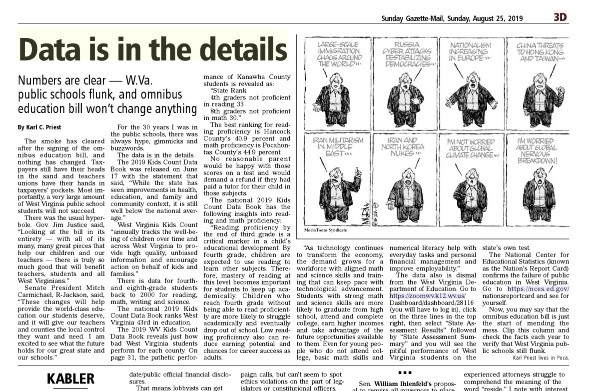EXODUS MANDATE-WV
Goals and Objectives | Christian Education | Resources for teaching| WV News | Articles
The Data is in the Details
By Karl C. Priest August 13, 2019 (revised 3-6-21)
The smoke has cleared after the signing of the omnibus education bill (Inaccurately called the “ Student Success Act.”) nothing has changed. Taxpayers still have their heads in the sand and teacher unions have their hands in taxpayers’ pockets. Most importantly a very large amount of West Virginia public school students will not succeed.
There was the usual hyperbole. Governor Justice said, “Looking at the bill in its entirety – with all of its many, many great pieces that help our children and our teachers – there is truly so much good that will benefit teachers, students, and all West Virginians.” Senate President Mitch Carmichael said, “These changes will help provide the world-class education our students deserve, and it will give our teachers and counties the local control they want and need. I am excited to see what the future holds for our great state and our schools.”
(http://wvmetronews.com/2019/06/28/justice-signs-omnibus-education-bill-putting-bow-on-pay-raises-and-opening-door-to-charters/)
For the thirty years I was in the public schools, there was always hype, gimmicks and buzzwords.
The data is in the details.
The 2019 Kids Count Data Book was released on June 17, 2019 with the statement that “ While the state has seen improvements in health, education, and family and community context, it is still well below the national average.” (https://www.wowktv.com/news/2019-kids-count-data-book-released/)
WV Kids Count “annually tracks the well-being of children over time and across West Virginia to provide high quality, unbiased information and encourage action on behalf of kids and families.” (https://wvkidscount.org/)
The indicators for f ourth and eighth graders not proficient in reading both state:
Definition: This is assessed using WESTEST (not NAEP which is what the national indicator for Annie E. Casey Foundation uses)
Source: West Virginia Department of Education; https://zoomwv.k12.wv.us/Dashboard/ portalHome.jsp
Years: 2016-2017 Academic Year (https://wvkidscount.org/wv-data-book/)
There is data for 4th and 8th grade students back to 2000 for reading, math, writing, and science.
The national 2019 Kids Count Data Book ranks West Virginia 43 rd in education (https://datacenter.kidscount.org/kids-count-data-book-interactive?l=54)
The 2019 WV Kids Count Data Book (2018 data), reveals just how bad West Virginia students perform for each county. On page 31, the pathetic performance of Kanawha County students is revealed as:
4th graders not proficient in reading State Rank 33
8th graders not proficient in math State Rank 30
The best ranking for reading proficiency is Hancock County’s 40.9% and math proficiency is Pocahontas County’s 44.9.
(https://data.wvkidscount.org/#/education ) No reasonable parent would be happy with those scores on a test and would demand a refund if they had paid a tutor for their child in those subjects.
The national 2019 Kids Count Data Book has the following insights into reading and math proficiency:
Reading proficiency by the end of third grade is a critical marker in a child’s educational development. By fourth grade, children are expected to use reading to learn other subjects. Therefore, mastery of reading at this level becomes important for students to keep up academically. Children who reach fourth grade without being able to read proficiently are more likely to struggle academically and eventually drop out of school. Low reading proficiency also can reduce earning potential and chances for career success as adults. (Pg 3o)
As technology continues to transform the economy, the demand grows for a workforce with aligned math and science skills and training that can keep pace with technological advancement. Students with strong math and science skills are more likely to graduate from high school, attend and complete college, earn higher incomes and take advantage of the future opportunities available to them. Even for young people who do not attend college, basic math skills and numerical literacy help with everyday tasks and personal financial management and improve employability. (Pg 31)
(https://www.aecf.org/m/resourcedoc/aecf-2019kidscountdatabook-2019.pdf)
The data is also dismal from the West Virginia Department of Education. Go to https://zoomwv.k12.wv.us/Dashboard/dashboard/28116, click on the three lines in the top right, then select “State Assessment Results” followed by “State Assessment Summary” and you will see the pitiful performance of West Virginia students on the state’s own test.
The National Center for Educational Statistics (known as the Nation’s Report Card) confirms the failure of public education in West Virginia. Go to https://nces.ed.gov/nationsreportcard/ , “Assessments”, then scroll down to “ How is Your State or District Performing?” and select “State and District Data Tools” and then select State Profiles” and see for yourself.
Now, you may say that the Omnibus Bill is just the start of mending the mess. Clip this column and check the facts each year to verify that West Virginia public schools still flunk as documented by the WV school news items found at http://www.insectman.us/exodus-mandate-wv/wv-news.htm.
---------------------------------------------
After op-eds (8-16) by pro-public school Senator Carmichael and (8-17) by State School Superintendent Paine, the article was published on August 25.
A screen shot is below.
The newspaper edited out (censored?) the following (in red) from the closing paragraph:
Now, you may say that the Omnibus Bill is just the start of mending the mess. Clip this column and check the facts each year to verify that West Virginia public schools still flunk as documented by the WV school news items found at http://www.insectman.us/exodus-mandate-wv/wv-news.htm.

See West Virginia text scores on the Nation’s Report Card.
|

